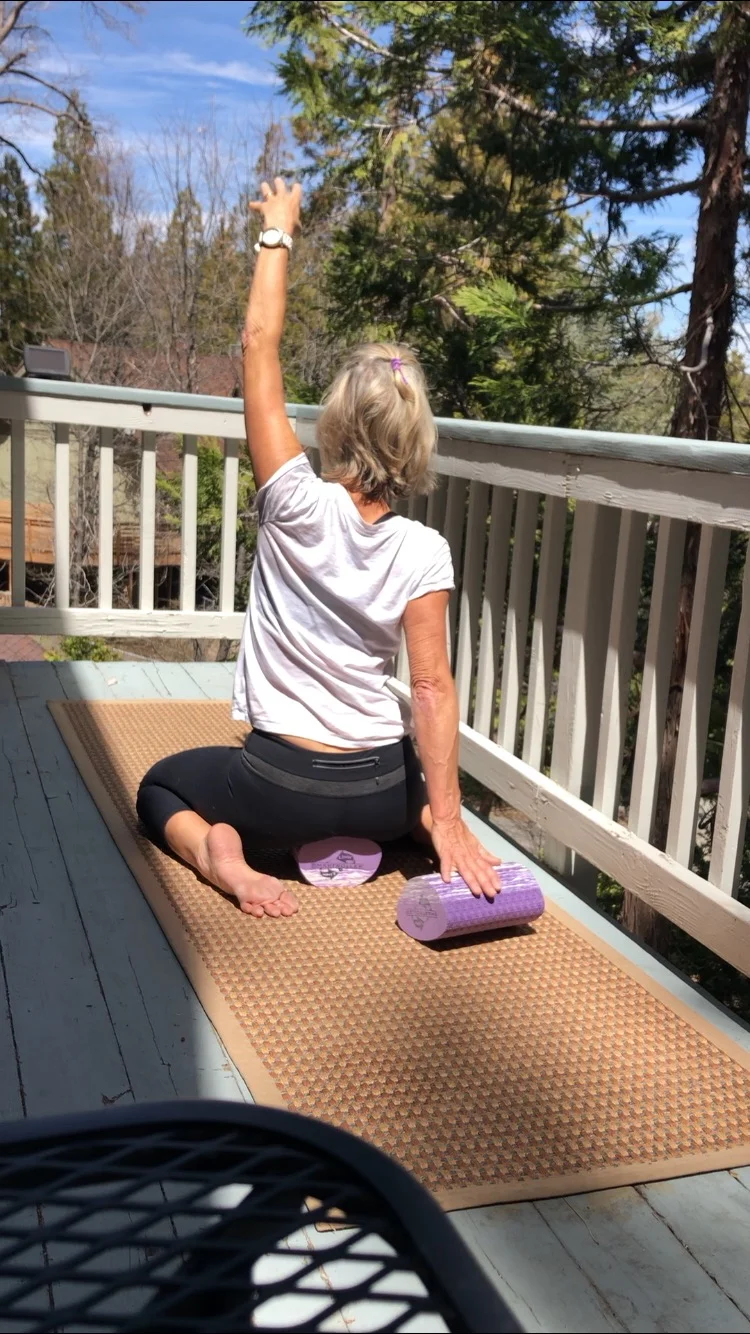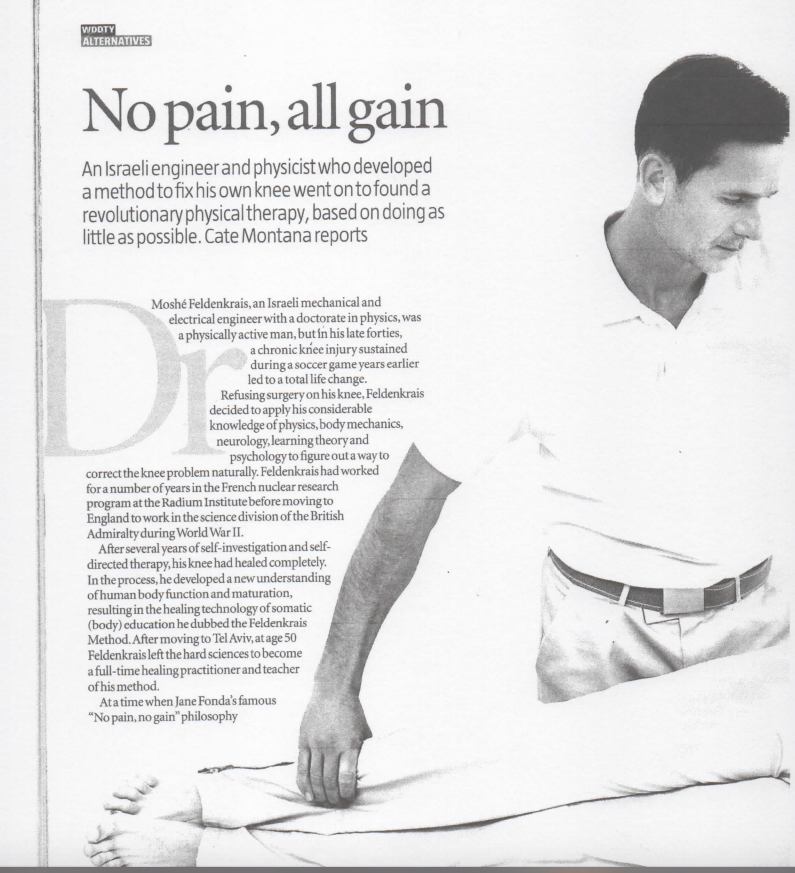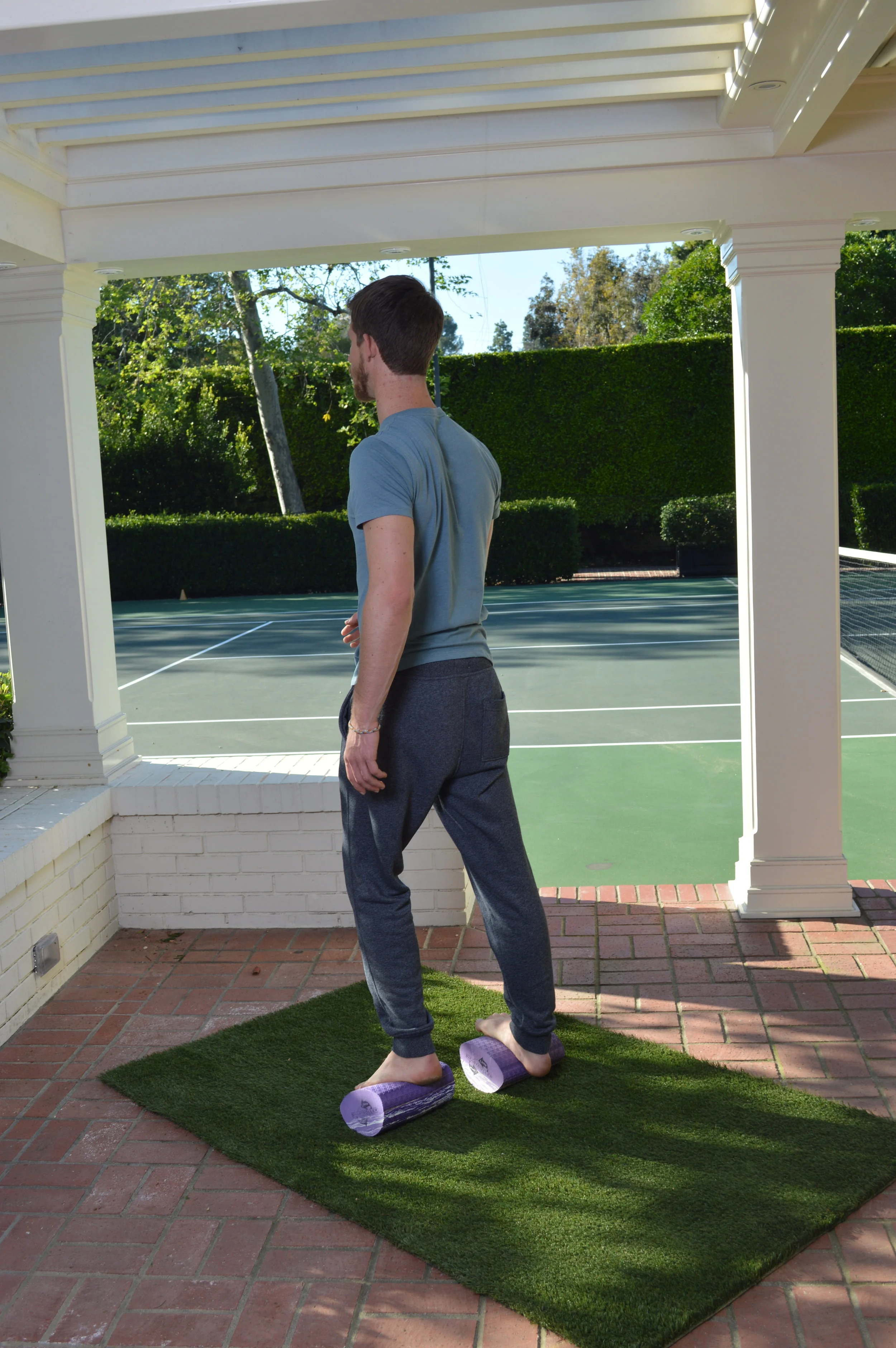What were you doing the last time you felt calm, comfortable in your body, free of stress, and positive about life? Were you walking in the woods? Playing golf? Skiing? Spending time with a particular person or a particular group of people? Stacy Barrows is a Los Angeles-based physical therapist and Feldenkrais® Pilates instructor who wants you to start paying attention to those pleasant experiences, so you can develop more of them. Read more here.
Smartroller LAB
“You have to do this as if you wanted to waste your time, but waste your time efficiently" (Feldenkrais, rg94, p. 149).”I have often been asked how do you use the Smartroller tools. Lately I am reminded of this concept and have tried to act on it with playing with the Smartroller tools to inspire new ideas and kinesthetic inquiry. I hope they inspire you.
Here are some visual aides on how to use the Smartroller and tools. Feldenkrais strategies work best with less use of the eyes. However, it can sometimes be challenging to know if you are on the right track. I am posting a few here, but I also recommend following on Instagram (@Smartroller) for weekly add ons. Here’s the thing, you don’t have to subscribe to Instagram to check out the vids, just search for Smartroller with Instagram and you will be able to see novel ways to use your Smart tools. Move to learn and enjoy! #LearningThroughTheNervousSystem
Mastering Ourselves: Smart Somatic Solutions
Attuning our senses to empower mastery in our everyday movement is our birthright. But somehow finding ease in getting up out of a chair, or finding quiet postures such as standing or sitting can be overlooked as ways we can find true grace with gravity.
I was recently reminded of what called me to teach in the field of movement. Helping others was so foundational to the core of how I was raised, so the field of physical therapy seemed to be the obvious place to start. My husband thinks I’m an enigma because I’m still passionate about my work. He also reminds me that not every conversation with others needs to be a discussion on becoming more aware of their movement.
So when I was introduced to foam rollers in my Feldenkrais training, I became excited on how these tools could help create the right conditions for learning through movement. We applied this experiential learning which is similar to how we learned as children to feel the freedom to move and sense ourselves in our environment. This playful learning allows us to foster our most innate intelligence to solve and evolve our movement and embodied skills. As adults, we need to be reminded of this. We become distracted with what we think we should do vs. what we feel we should do. This happens partly because our felt sense has been diminished through the lack of creative self guided movement. There also is a lack of trusting ourselves, and feeling the need to ask others to direct us to move correctly.
“You have to do this as if you wanted to waste your time, but waste your time efficiently
-Moshe Feldenkrais ”
Here is an example of my most recent experience with this…
A dear friend, Susan Dopart, a highly respected international Motivational Interview teacher offered this story as she was teaching Life Style Solutions–
She witnessed one of her students was experiencing back pain from his long commute to her workshop. She offered to him her Smartroller® to see if this could ease his discomfort. As she describes it, she just told him to get on the Smartroller without telling him what to do. He not only trusted his own sense of curiosity to play with movement, but he later says, “2 minutes on the Smartroller was like an hour of Yoga.” He was also observed to move more comfortably the rest of the day.
True mastery :-)
Join me as we explore further with smart somatic solutions at the FGNA 2018 Conference.
“2 minutes on the Smartroller is better than 1 hour of Yoga” Maynard Hearns”
Meet Susan Bass AND Century City Physical Therapy
Today we’d like to introduce you to Susan Bass.
Susan, please share your story with us. How did you get to where you are today?
My business partner, Stacy Barrows and I worked part-time as independent contractors in a well respected orthopedic practice. Due to a multitude of factors, the corporation broke up and we were offered the physical therapy practice including the equipment. Within one months time, with no prior business experience or knowledge of how to operate a practice, we rented space in the existing medical building and started Century City Physical Therapy Inc. (CCPT) With no initial capital structure nor financial backing, Stacy and I were required to see patients outside the practice to help subsidize our new endeavor.
Neither of us were able to withdraw any income from the practice for the first 6 months and had no support staff. Within 1 year we were able to hire our first employee and work solely at CCPT. Our phenomenal culture of high-quality evidence-based care incorporating wellness with rehabilitation in an intimate patient-focused environment has sustained us for 23 years. Besides traditional physical therapy, we also offer complementary healthcare such as pilates, Feldenkrais®, and personal training. Read more here!
No Pain, all Gain
Felden...Krais? Some people claim that this method is easy to experience, but may be difficult to explain. I would agree. After years of studying this work, and teaching this method, I do find it hard to explain in our modern world of "no pain more gain."
I am copying an article here written by Cate Montana that helps illuminate this work and supports why we should all investigate learning the Feldenkrais way. Read more here.
SPINAL CHAIN-PREPARATION FOR PILATES STANDING ROLL DOWN
This has been an exciting week with the Feldenkrais Awareness Summit through Future Life Now.
I had the pleasure to speak to teachers around the world, trained in Feldenkrais, Yoga, Pilates, Personal Training and more. I am posting the standing roll down lesson I created to access imagery for core coordination with a Feldenkrais lens of awareness. Enjoy. Please post comments on your experience. Thank you.
Start with a check in. Notice how you are standing and the support from the ground. Slowly lift one arm and then the other so you can sense the connection to your spine, legs, feet, lower abdomen, shoulders and breath.
Walk over to the wall. Gently lean your back into the wall, without pushing into it. Walk your feet out about one foot away and allow your feet to be under your hip joints.
Notice the contact of your back to the wall. Notice your breath. Sense the ground support. Without moving, how far away is your head from the wall. Slowly take your head back to make light contact and notice where you touch and the actual distance. Then return your head to your starting position.
Slowly shrug your shoulders and lower them down with gravity to notice their location on your body. Slide your right hand down your right leg, allowing your spine to curl in that direction. Notice your ease and how your spine segments adapt to the movement, then return. Slide your left arm down your left leg to notice how the two sides compare. Pause in the middle.
Gently slide down the wall, bending your knees and ankles. Only go as far as you can do it to sense a fuller contact of your back to the wall and not to overly engage your legs. This is not a wall slide exercise. Pause in this position and make sure you take plenty of rests as you need to by sliding back up the wall.
Gently roll your pelvis under and then slightly arched, as if you are doing 12-6 with the pelvic clock on the wall. Sense how you do this. Can you soften your belly to make the movement fluid and easy? Which way is easier? Rest and slide back up the wall.
Slide back down the wall as before, and pause. This time start to roll out the spine by moving your pelvis away from the wall, detaching your spine, segment by segment. Then return to the wall, noticing how you reverse the movement. Do this a few times, noticing your breath, weight shift through your feet, how your eyes participate and how this effects the way your arms hang down.
Rest, by sliding back up the wall.
Slide down again and pause in the same position. Rest your hands on your thighs and gently slide both hands down towards your feet. Don’t go very far, just enough to sense your spinal chain movement and repeat this a few times, reversing the movement back to your start position. Pause.
Do the same movement, but this time put both hands on your right thigh and slide them down on the right side. Repeat this a few times.
Try this on your left side. How do they compare?
Rest back up with your legs long.
Now imagine a space, a cylinder, “a constellation of attention*” measuring just under your first ribs, just above your pelvic floor; from below the width of your sits bones and from above the two mastoid processes of your skull. This is not anatomical and an approximation just for you to attune to this space. Take your hands and move them towards each other to gain more awareness of the space you are mapping in your imagination. Sense that there is almost an energy to the space. If you allowed yourself to really attend to it without tension, it may feel like it is subtly pushing back out into your hands. Move your hands in a few places, to the sides of the cylinder, and from top to bottom of the cylinder.
Now rest your arms by your sides. With your legs out long, start the Pilates roll down exercise, beginning at your head and eyes. Articulate bending from the top down, segment by segment as if you are a soft willow tree bending to just about your knee caps (if that is easy and comfortable). Allow your arms to hang free and to dangle. Reimagine your cylinder, and the reformed shape.
Start to roll back up, by imagining your cylinder is the support, and giving you inner strength to ease back up, and allowing your spine to ease into the wall, segment by segment. Take your time, and allow your breath to be easy and un-interfered with. Continue until you fully reach your full height. Pause and sense your inner and outer space. Move your arms to the wall, and lightly press into the wall to shift you back onto your feet to come to full standing without the wall support. What do you notice?
Take this with you and try and imagine this when you lift something, push something, or even exercise to reach your full potential. Thank you.
*Olena Netifor reference LA regional event 2017









